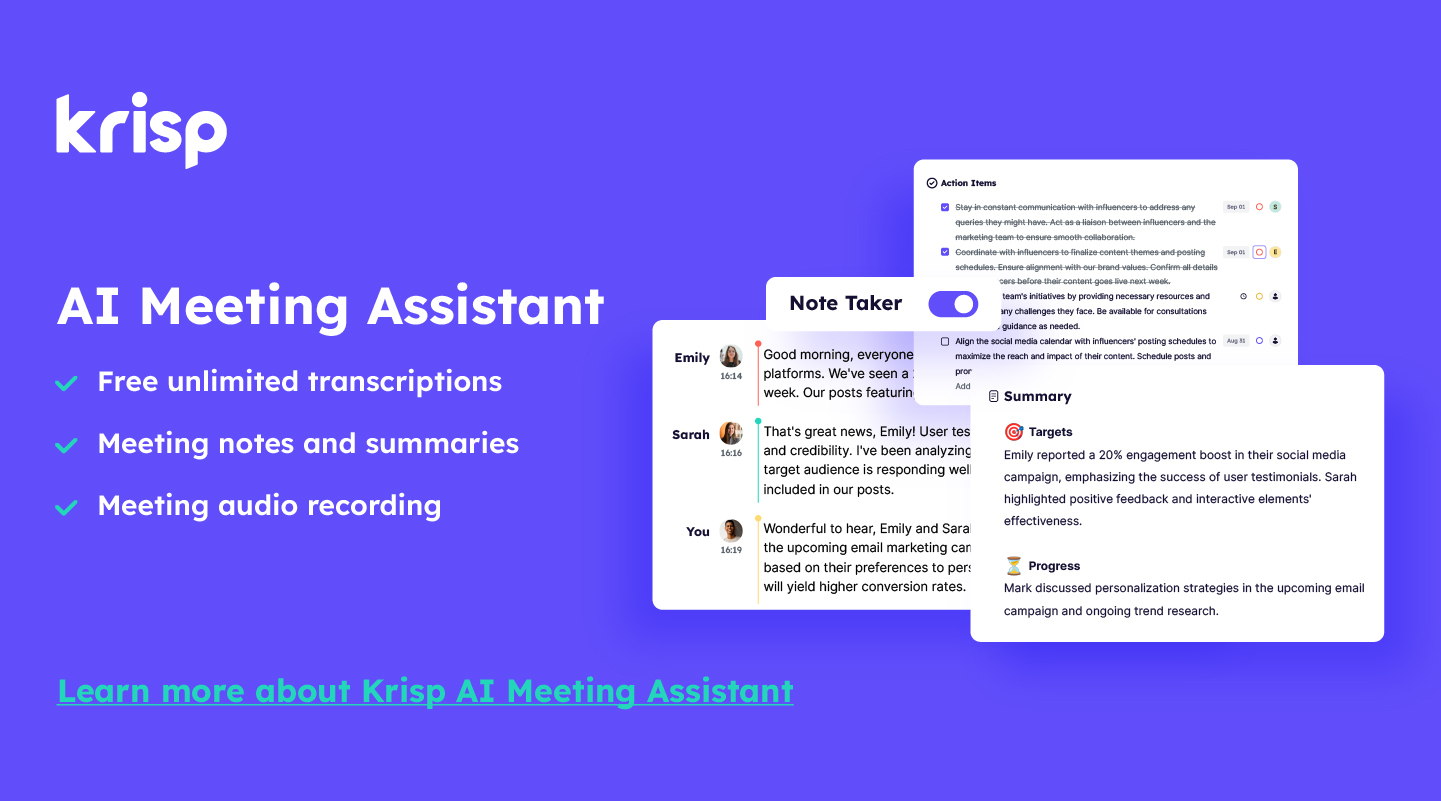Looking for team meeting games to energize your team and spark creativity? Games are not just for fun. They can break the ice, boost collaboration, and bring fresh ideas to life. Both for warming up a virtual meeting or fueling a brainstorming session, the right game can turn dull meetings into engaging and productive experiences.
From quick icebreakers like “Two Truths and a Lie” to creativity-boosting activities like Crazy 8s, there is something for every team dynamic. In this article, we explore the best games and how Krisp can help make them even more effective.
Key Takeaways
- Choose games that align with the meeting’s objective, whether icebreaking, brainstorming, or problem-solving.
- Consider the team size, dynamics, and comfort levels when selecting games to ensure inclusivity and participation.
- Short, focused games work best for quick energizers, while longer sessions can accommodate creativity-boosting or problem-solving activities.
- Virtual and in-person games require different setups, so select tools or formats that fit your team’s work environment.
- Balance fun and productivity by rotating between different game types and keeping the experience fresh.
- Avoid games that are overly complex, time-consuming, or likely to cause discomfort among participants.
- Games like Crazy 8s, Brainwriting, and Reverse Brainstorming are ideal for brainstorming, while Digital Pictionary and online trivia suit remote teams.
- Use Krisp’s AI-powered features to minimize distractions and improve communication during team meeting games.
- Krisp’s AI Meeting Assistant can take notes and summarize key takeaways from brainstorming games, so participants stay focused and present.
- Post-game debriefs and feedback help teams reflect on game outcomes and improve future meetings.
The 12 Best Team Meeting Games for Different Needs
Here’s a selection of games designed to serve different purposes, from breaking the ice to sparking creativity and promoting collaboration. You’ll find options to suit any setup for both on-site and remote teams.
Icebreakers to Set the Mood
1. Two Truths and a Lie
Best for: Breaking the ice and helping team members learn fun facts about each other.
How to play:
- Each participant shares three statements about themselves: two that are true and one that is a lie.
- The rest of the team asks questions and discusses the statements to determine which one is the lie.
- After guesses are made, the participant reveals the lie.
- Continue until everyone has had a turn.
Why it works: It encourages laughter and curiosity, making it easier for team members to bond.
2. Would You Rather
Best for: Starting casual conversations and easing teams into meetings.
How to play:
- Prepare a list of fun and thought-provoking “Would you rather…” questions (e.g., “Would you rather work remotely forever or in an office with unlimited snacks?”).
- One person reads a question, and each team member quickly shares their choice and a brief explanation.
- Continue with different questions for as long as desired.
Why it works: It sets a playful, relaxed tone, encouraging participation and creativity.
3. Show and Tell
Best for: Building personal connections and fostering empathy.
How to play:
- Ask each participant to bring something meaningful to them (e.g., a souvenir, photo, or book).
- One by one, team members present their item and explain its significance.
- Others can ask questions or share related stories.
Why it works: It helps team members learn about each other’s backgrounds and experiences, creating stronger connections.
Games to Boost Creativity
4. Crazy 8s
Best for: Generating a high volume of ideas quickly during brainstorming sessions.
How to play:
- Provide participants with a problem or challenge to solve.
- Give each person a piece of paper divided into 8 sections or a digital board.
- Set a timer for 8 minutes, during which each participant sketches or writes down 8 different ideas. 4. Once time is up, participants can share and discuss their ideas with the group.
Why it works: The time constraint forces participants to think quickly, leading to creative and often unconventional ideas.
5. Brainwriting
Best for: Encouraging contributions from everyone, especially quieter team members.
How to play:
- Present a problem or topic to the team and distribute sticky notes or digital brainstorming tools.
- Ask each participant to write down 3-5 ideas in silence within a set time frame.
- Once time is up, team members pass their ideas to someone else, who adds or builds on them.
- After several rounds, discuss the ideas as a group and prioritize them.
Why it works: It eliminates the pressure of speaking up immediately and ensures that all voices are heard.
6. Collaborative Storytelling
Best for: Enhancing creativity, storytelling, and team synergy.
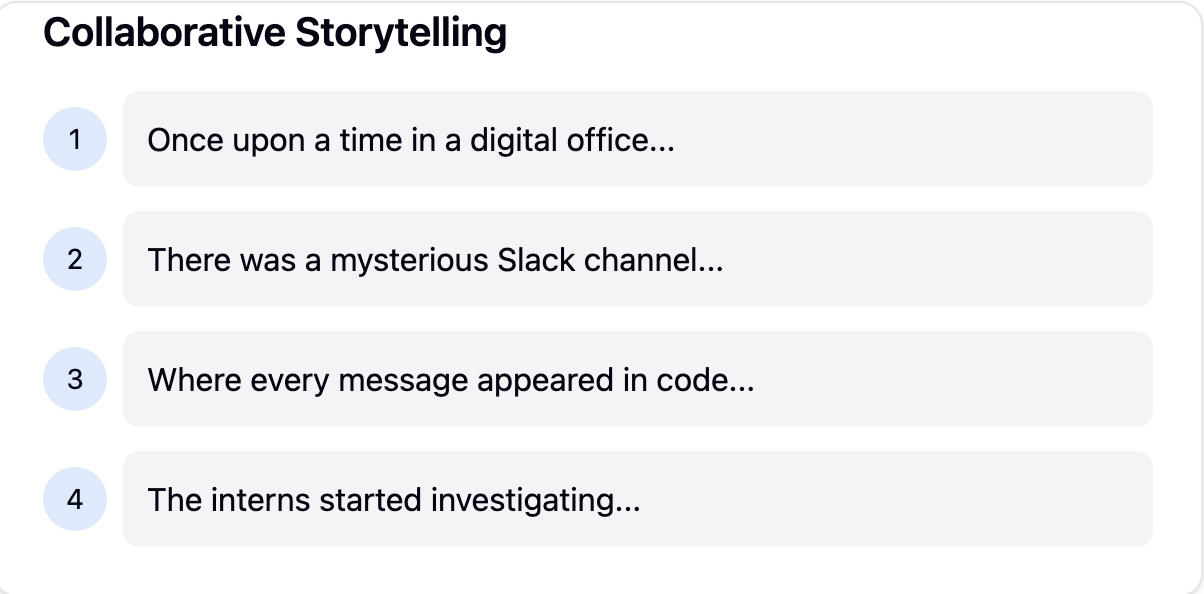
How to play:
- Start with a sentence or prompt (e.g., “It was a stormy night when…”) and ask one participant to continue the story.
- Each team member adds a sentence or idea in turn, building on the previous contribution.
- Continue until the story reaches a natural conclusion or set time limit.
- Share and reflect on the story as a group.
Why it works: It promotes teamwork, active listening, and creative thinking.
Collaboration and Problem-Solving Games
7. Reverse Brainstorming
Best for: Identifying hidden problems and generating creative solutions.
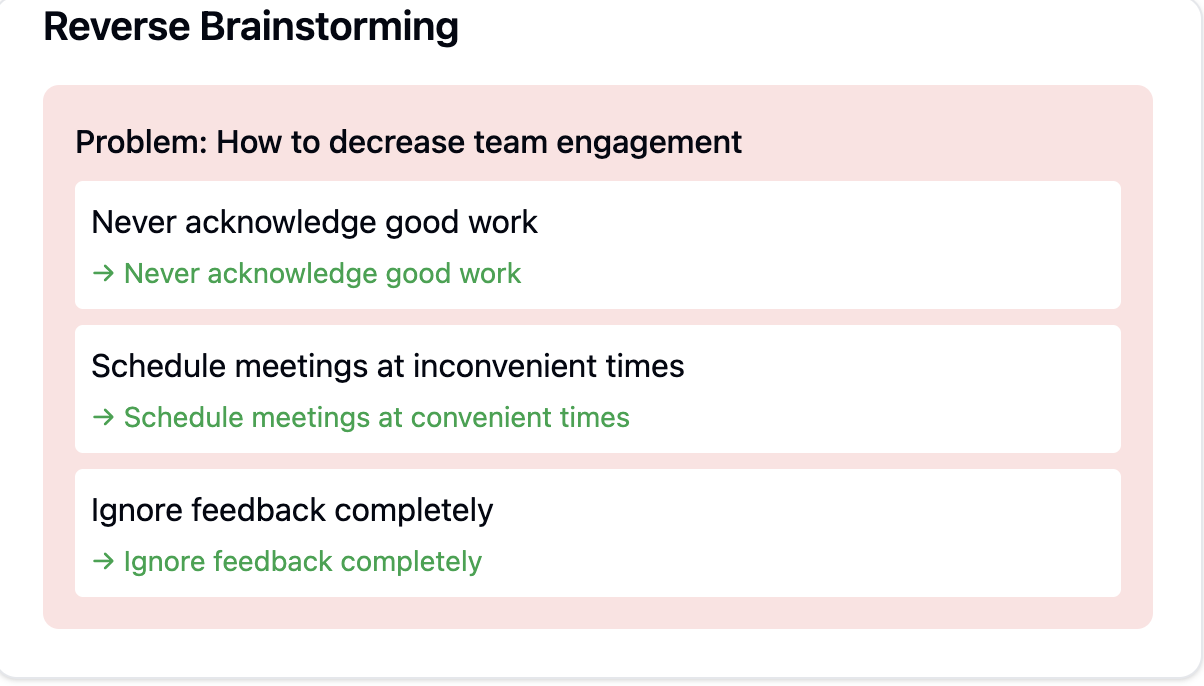
How to play:
- Define a challenge or problem the team wants to solve.
- Instead of brainstorming solutions, brainstorm ways to cause or worsen the problem.
- Once a list of “problems” is generated, reverse-engineer them into possible solutions.
- Prioritize the most promising solutions and discuss actionable steps.
Why it works: It encourages out-of-the-box thinking and highlights overlooked solutions.
8. Marshmallow Challenge
Best for: Improving team collaboration, problem-solving, and adaptability.
How to play:
- Divide participants into small teams of 3-5 members.
- Provide each team with 20 sticks of spaghetti, 1 yard of tape, 1 yard of string, and 1 marshmallow.
- Set a 20-minute timer. The goal is to build the tallest freestanding structure that can support the marshmallow on top.
- When time is up, measure each team’s structure to determine the winner.
Why it works: It emphasizes teamwork, creativity, and learning from failure in a fun, hands-on way.
Virtual Team Meeting Games
9. Digital Pictionary
Best for: Keeping energy levels high during virtual meetings.
How to play:
- Use a digital whiteboard tool or Pictionary app.
- Divide the team into two or more groups.
- One player from each group receives a prompt and draws it on the digital board while their teammates guess the word or phrase.
- Set a time limit for each round, and award points for correct guesses.
Why it works: It’s an engaging, interactive game that brings remote teams together.
10. Online Trivia
Best for: Building team camaraderie through friendly competition.
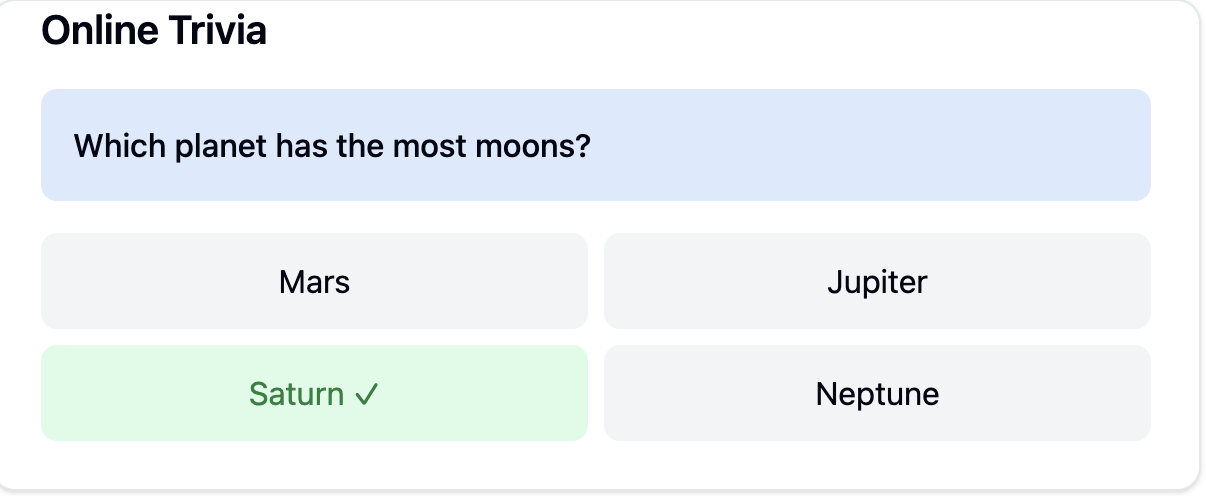
How to play:
- Prepare a trivia quiz or use an online trivia platform.
- Divide participants into small teams, and assign a quiz master.
- Ask questions on topics like general knowledge, pop culture, or company history, and award points for correct answers.
- The team with the most points at the end wins.
Why it works: It’s a fun and inclusive way to encourage participation, especially in remote settings.
11. Guess the Emoji
Best for: Quick, fun breaks that spark creative thinking.

How to play:
- Create a list of emoji sequences that represent common phrases, movie titles, or work-related tasks.
- Display each sequence, and have participants guess the phrase within a time limit.
- Award points for correct guesses, and continue with different sequences.
Why it works: It energizes the team and encourages creative problem-solving.
12. Virtual Scavenger Hunt
Best for: Boosting energy and engagement in virtual meetings.

How to play:
- Create a list of items participants can find in their homes or workspaces (e.g., a book with a blue cover, a coffee mug).
- Share the list, and set a timer for participants to find as many items as possible within the time limit.
- Participants return to the video call and share what they’ve collected.
- Award points for each item found, and declare a winner.
Why it works: It breaks up long virtual meetings with an exciting and interactive activity.
Do’s and Don’t in Team Meeting Games
| Do’s ✅ | Don’ts 🚫 |
|---|---|
| ✅ Align games with your meeting objectives: Choose games based on the goal (icebreaking, creativity, or collaboration). | 🚫 Don’t force participation: Allow team members to opt out or observe if they’re uncomfortable. |
| ✅ Set clear rules and expectations: Provide instructions upfront to avoid confusion. | 🚫 Don’t choose overly complicated games: Keep the rules simple to avoid wasting time. |
| ✅ Encourage participation: Create an inclusive environment where everyone feels welcome to join. | 🚫 Don’t let games dominate the meeting: Balance fun with productivity to stay on track. |
| ✅ Keep games short and focused: Ensure they fit the meeting length and maintain energy. | 🚫 Avoid games that alienate or embarrass: Stay away from activities that could cause discomfort. |
| ✅ Adapt games for remote or hybrid settings: Make sure games are engaging for all locations. | 🚫 Don’t forget the purpose: Every game should serve a clear goal, whether fun or functional. |
| ✅ Gather feedback afterward: Ask team members if the game added value to the meeting. | 🚫 Don’t skip debriefing: For brainstorming or problem-solving games, discuss key takeaways. |
How to Choose the Right Team Meeting Games
Selecting the right team meeting game isn’t just about having fun. It’s about choosing activities that align with your team’s objectives, comfort levels, and dynamics to maximize productivity and engagement. Here’s an in-depth guide to help you make the right decision:
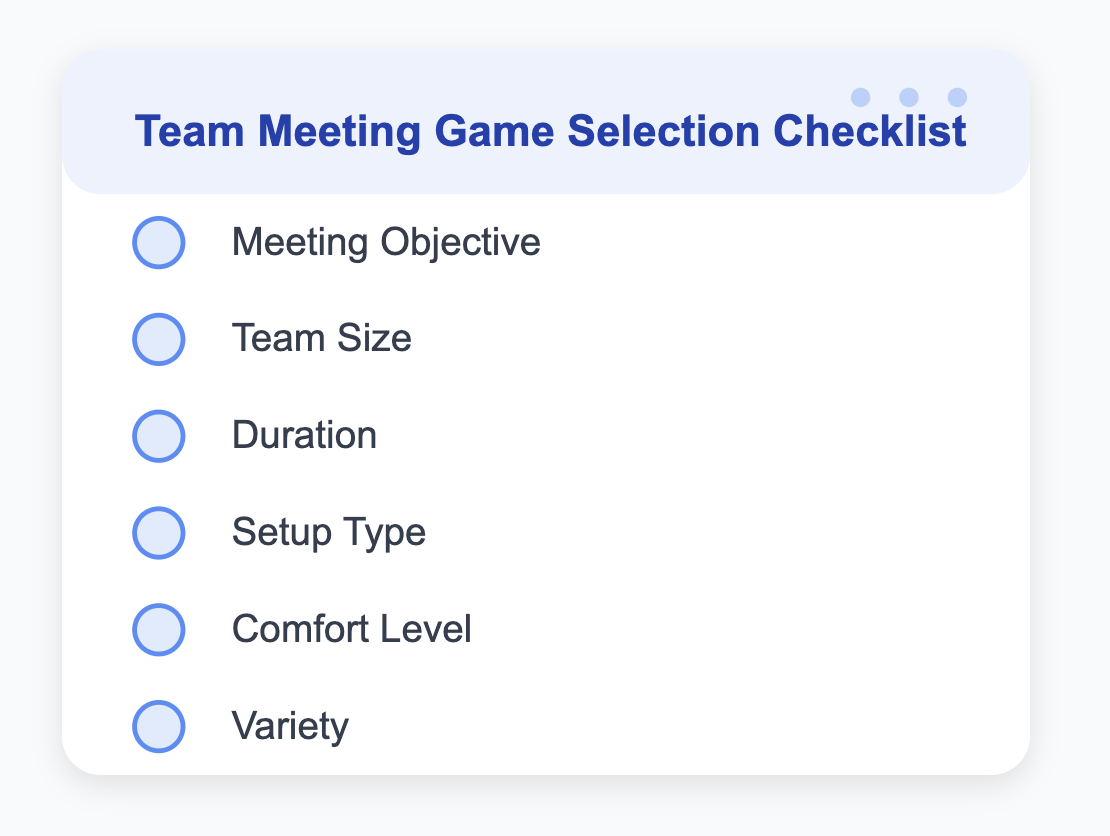
Meeting Objective: What Are You Trying to Achieve?
The most important factor in choosing the right game is identifying your goal. Different games serve different purposes, and selecting the right type ensures you meet your objective without wasting time.
- Icebreakers: These games are ideal for warming up the team, especially if the group is new or if the meeting is early in the day.
- Creativity-boosting games: Perfect for brainstorming sessions, they help generate ideas quickly and foster innovation.
- Problem-solving games: These encourage collaboration and critical thinking, making them useful for meetings focused on tackling challenges.
- Team-building games: Great for fostering trust and bonding, particularly after completing major projects or during team retreats.
| Example: For a team struggling to generate fresh ideas, a creativity-focused game like Crazy 8s would be effective. Conversely, if the goal is to establish rapport, use icebreakers like Two Truths and a Lie. |
Team Size and Dynamics: Who Is Participating?
The number of participants and their relationship with each other are crucial in determining the right game. Smaller teams often benefit from games that require deeper collaboration, while larger teams may prefer games that involve groups or breakout sessions.
- New teams: Opt for simple, inclusive icebreakers to help team members get to know one another.
- Established teams: Go for more challenging, collaborative activities to strengthen bonds and foster problem-solving.
- Large teams: Consider games where you can divide participants into smaller groups for better engagement.
- Small teams: Choose activities that allow every participant to contribute equally without being overwhelmed.
| Example: For large teams, games like trivia competitions can work well because they can be played in groups. For small teams, try collaborative games like the Marshmallow Challenge or Brainwriting. |
Meeting Duration: How Much Time Do You Have?
Games should fit within your meeting’s timeframe without taking away from its primary purpose. If your meeting is brief, opt for games that take 5–10 minutes to complete. For longer meetings, you can introduce more complex activities or dedicate specific sections of the meeting to games.
- Short meetings (under 30 minutes): Choose quick, engaging icebreakers or warm-up games.
- Medium-length meetings (30–60 minutes): Introduce creativity-boosting or problem-solving games that don’t require lengthy explanations.
- Long meetings (over 60 minutes): Consider adding more detailed collaborative activities with time for discussion or debriefing afterward.
| Example: For a 20-minute meeting, a quick game like Would You Rather can help break the ice. In contrast, for a 90-minute brainstorming session, Reverse Brainstorming or Crazy 8s would fit better. |
Virtual or In-Person Setup: Where Is the Team Located?
Whether your team is working remotely, in the office, or in a hybrid setup affects the type of games you can play. Virtual games should rely on tools like digital whiteboards or online platforms, while in-person games can be more physical and interactive.
- Virtual meetings: Choose games that use digital tools, such as online trivia, virtual scavenger hunts, or Pictionary using a drawing app.
- In-person meetings: Opt for hands-on activities like team-building challenges or collaborative brainstorming games.
- Hybrid teams: Use a combination of online and in-person games to ensure all participants are equally engaged.
| Example: For remote teams, Digital Pictionary using a whiteboard tool can energize participants. For in-person settings, try a collaborative game like the Marshmallow Challenge. |
Inclusivity and Comfort: Are All Team Members Comfortable?
Consider the personalities, cultural backgrounds, and comfort levels of your team members. Games should be inclusive and fun without creating situations that might make someone feel uncomfortable or embarrassed. Avoid games that require too much personal sharing, as they can lead to awkwardness.
- Invite everyone can participate: Choose games that allow all team members to contribute, regardless of their role or personality type.
- Avoid overly competitive games: Unless the team thrives on competition, avoid games that could lead to stress or division.
- Respect boundaries: Be mindful of cultural sensitivities and individual preferences when choosing games.
| Example: Stick to light-hearted games like Show and Tell or Guess the Emoji for new teams. For teams with stronger bonds, collaborative games or trivia can work well without discomfort. |
Variety and Engagement: Are You Keeping Things Fresh?
Repeating the same games in every meeting can cause boredom. To maintain engagement, rotate between different types of games, such as icebreakers, problem-solving challenges, and creativity boosters. Keep the games varied to stimulate different thinking styles and maintain interest.
- Mix up game types: Alternate between individual and group-based games, creative and logical challenges, and high- and low-energy activities.
- Introduce new games periodically: Add new games to the rotation to keep the experience fresh and exciting.
- Balance fun and productivity: Ensure games aren’t just entertaining but also contribute to the meeting’s success.
| Example: For brainstorming meetings, alternate between Crazy 8s, Brainwriting, and Reverse Brainstorming to prevent monotony. |
Alignment with Team Culture: Does the Game Fit Your Team’s Personality?
Your team’s culture, work style, and shared values should guide the type of games you choose. A creative, laid-back team may enjoy playful and imaginative activities, while a more structured team may prefer logical problem-solving games. The game should feel natural to the group rather than forced.
- Creative teams: Choose storytelling games or design challenges to let their imagination run wild.
- Structured teams: Opt for problem-solving games that require logic and collaboration.
- Humorous teams: Light-hearted games involving jokes or fun facts can fit their dynamic.
| Example: For a tech-oriented team, consider digital escape rooms or tech-themed trivia. For marketing or creative teams, Collaborative Storytelling can spark creativity. |
How Krisp Can Make Team Meeting Games More Productive
Krisp enhances team meeting games by creating a focused and distraction-free environment. Here’s how it helps maximize productivity:
- Eliminates background noise distractions: AI-powered noise cancellation blocks unwanted sounds, ensuring smooth and uninterrupted gameplay.
- Improves communication clarity: Participants hear and understand instructions, feedback, and discussions without miscommunication.
- Fosters engagement in hybrid setups: Balances participation between in-person and remote team members by providing clear, noise-free audio for everyone.
- Keeps participants present with AI note-taking: Krisp’s AI Meeting Assistant handles notes and summaries, letting team members stay focused on the game.
- Reduces fatigue and boosts energy: Clear, noise-free communication prevents cognitive overload, helping participants stay engaged and energized.
- Supports effective post-game discussions: Summarized notes from Krisp make it easy to reflect on game outcomes and actionable insights.
FAQs


